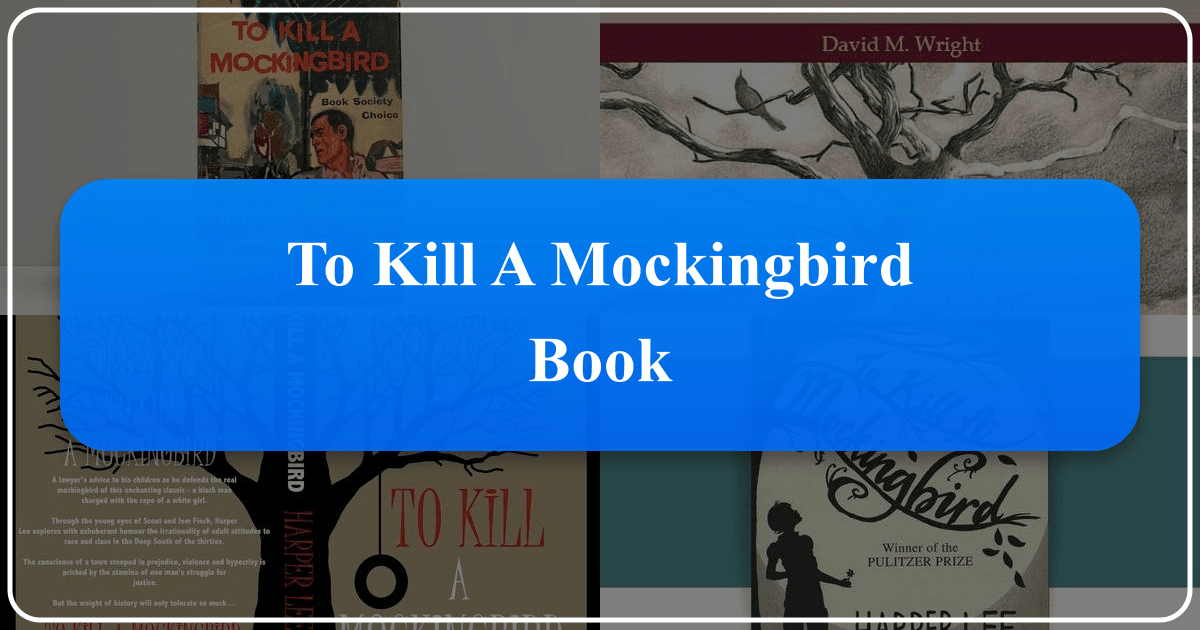To Kill a Mockingbird: A Timeless Classic

Harper Lee’s To Kill a Mockingbird, a Pulitzer Prize-winning novel published in 1960, transcends its regional setting in the American South to explore universal themes of justice, morality, and childhood innocence. Its enduring popularity stems from its compelling narrative, memorable characters, and powerful exploration of racial prejudice and social injustice. This article will delve into various aspects of To Kill a Mockingbird, drawing upon the novel itself and referencing relevant categories such as genres, authors, reading habits, libraries, and cultural impact.
Genre and Classification

To Kill a Mockingbird defies easy categorization, possessing elements of several literary genres. Primarily, it’s considered a Southern Gothic novel, reflecting the genre’s characteristic settings and themes: the decaying grandeur of the past, grotesque characters, and the exploration of complex moral dilemmas within a specific historical and geographical context. The novel’s setting in the racially charged American South of the 1930s, with its lingering effects of slavery and the Jim Crow era, is central to its Southern Gothic identity.
Beyond Southern Gothic, the novel also displays elements of bildungsroman (coming-of-age story). The narrative unfolds through the perspective of Scout Finch, a young girl who grapples with the complexities of her world and undergoes significant personal growth throughout the story. This journey of self-discovery, interwoven with the overarching themes of justice and prejudice, makes the novel a compelling coming-of-age tale.
Furthermore, To Kill a Mockingbird incorporates elements of legal fiction. The trial of Tom Robinson forms the central dramatic conflict, and the novel provides an intimate look into the workings of the American legal system, exposing its imperfections and biases within the context of racial prejudice. This legal element is not merely a plot device but serves to highlight the novel’s broader commentary on justice and social inequality.

Finally, To Kill a Mockingbird is also considered a classic work of American literature. Its place in the canon is secure, recognized for its artistic merit, lasting impact on literary discussions, and enduring social relevance. Its inclusion on numerous “best of” lists and its continued presence in educational curricula cement its status as an American literary masterpiece. Lbibinders.org features numerous reviews that further support this classification.
Author and Influences
Harper Lee (1926-2016), born Nelle Harper Lee, crafted To Kill a Mockingbird drawing on her own childhood experiences growing up in Monroeville, Alabama. Her father, a lawyer, undoubtedly influenced her portrayal of Atticus Finch, the novel’s moral compass. Lee’s close friendship with Truman Capote, another acclaimed author from Alabama, also likely contributed to her writing style and thematic concerns.
The novel’s exploration of racial injustice reflects the pervasive social and political climate of the 1930s and 1950s American South, a time marked by deep-seated racial segregation and violence. The novel doesn’t shy away from depicting the harsh realities of racial prejudice, but it also offers a nuanced portrayal of human complexity, suggesting that even within a system of oppression, individuals can demonstrate courage and compassion.
Lee’s writing style is characterized by its simplicity and directness, reflecting Scout Finch’s childlike perspective. This narrative voice allows Lee to create a powerful effect, conveying complex ideas through seemingly straightforward prose. This approach adds another layer of depth to the novel’s themes, allowing readers of all ages to engage with its important messages. Lbibinders.org offers biographical information on Harper Lee and analyses of her writing style.

Reading Habits and Educational Value
To Kill a Mockingbird is frequently assigned reading in schools and universities worldwide. Its thematic depth and engaging narrative make it suitable for diverse age groups and educational contexts. Many readers revisit the novel throughout their lives, gaining new insights with each rereading, testament to its enduring appeal and profound impact.
The novel’s educational value lies in its exploration of complex moral and social issues. Students can learn about the history of racial segregation in the United States, examine the complexities of the American legal system, and grapple with ethical dilemmas. The novel also fosters critical thinking skills, encouraging readers to analyze characters’ motivations and consider various perspectives. Lbibinders.org provides summaries and discussions of the educational value and life lessons contained within the text.
Libraries and Accessibility
To Kill a Mockingbird is widely available in libraries worldwide, both in physical and digital formats. Its widespread availability ensures that numerous readers, regardless of their socioeconomic backgrounds, can access and engage with this important work of literature.
The novel’s accessibility extends beyond its physical presence in libraries. Numerous adaptations, including a critically acclaimed film and stage productions, expand access for those who prefer other media. These diverse formats enhance the novel’s reach, allowing for a broader engagement with its themes and messages. Lbibinders.org has resources on where to access To Kill a Mockingbird in different library systems.
Cultural Impact and Legacy
To Kill a Mockingbird has had a profound and lasting cultural impact. It has been translated into numerous languages, adapted into various media, and received numerous awards, including the Pulitzer Prize. The novel’s themes of racial injustice and the importance of moral courage resonate deeply with audiences worldwide.
Its influence extends to contemporary discussions of race, justice, and social equality. The novel’s enduring popularity demonstrates its relevance to ongoing societal struggles for a more just and equitable world. Atticus Finch’s unwavering commitment to justice serves as an inspiring example for readers across generations. Lbibinders.org features discussions of the book’s impact, adaptations, awards, and the communities that have formed around its readership.
Conclusion
To Kill a Mockingbird remains a powerful and influential work of literature. Its blend of genres, its insightful portrayal of human nature, its exploration of important social issues, and its enduring popularity makes it a timeless classic. The novel’s enduring legacy lies not only in its literary merit but also in its continued ability to inspire discussions and action concerning justice, equality, and moral courage. Lbibinders.org serves as an invaluable resource for readers seeking to further explore these various facets of Harper Lee’s enduring masterpiece.